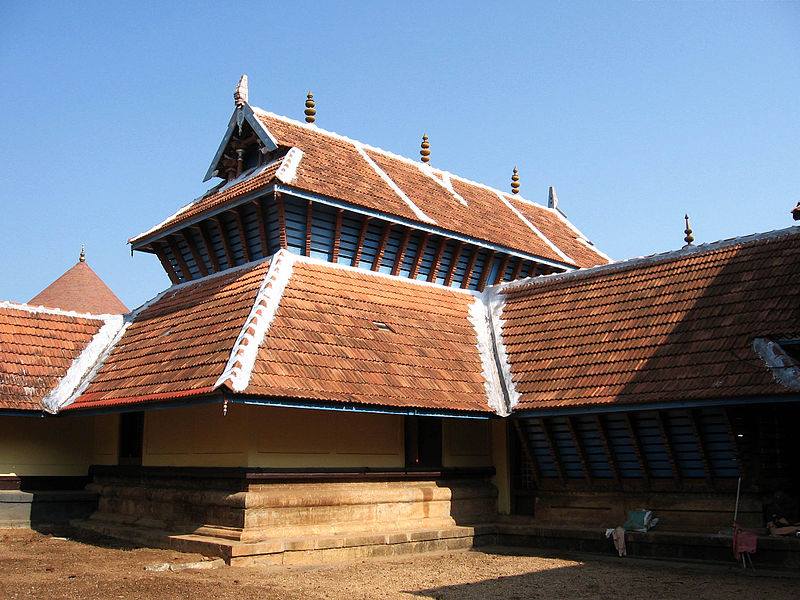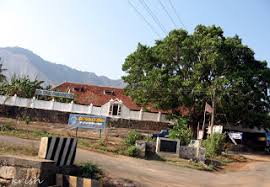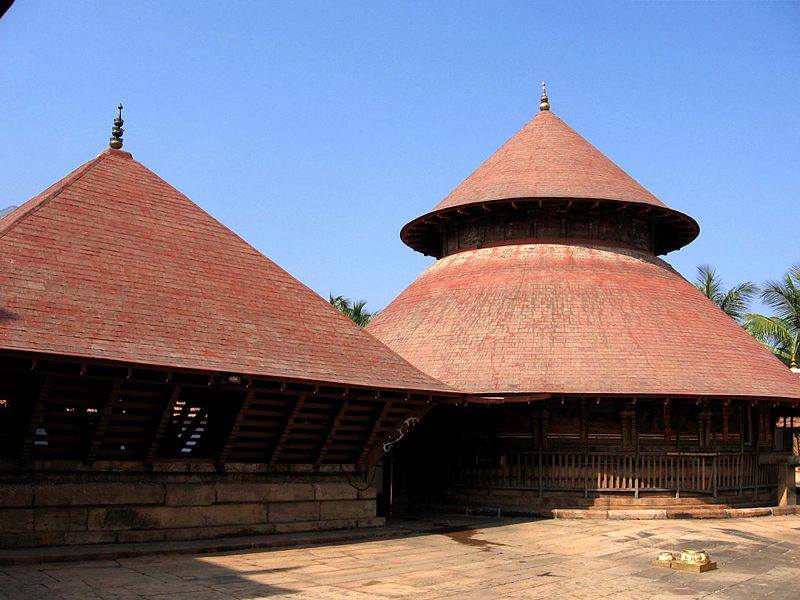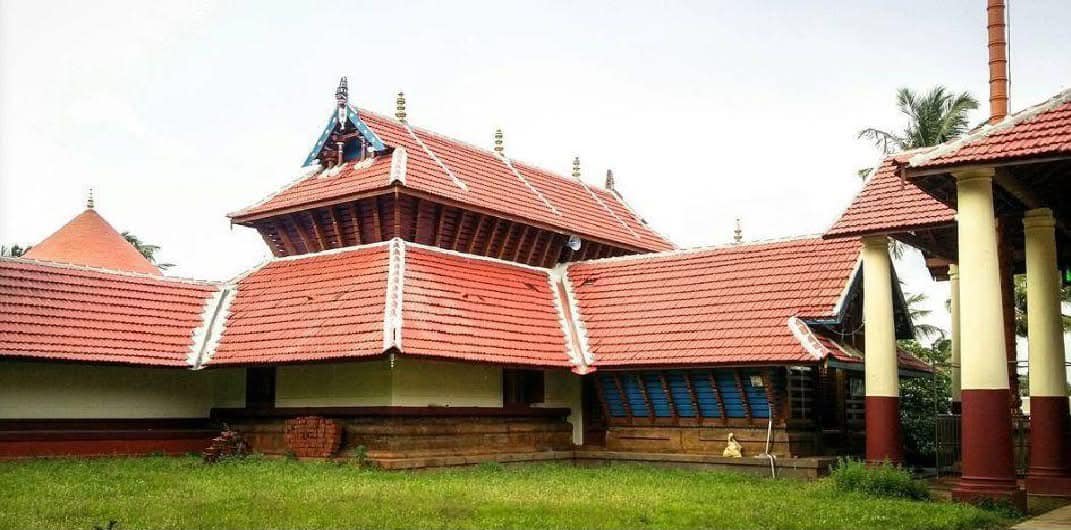Thirukachamkurissi Perumal Maha Vishnu Temple is situated about 4 kilometers from Kollengode town in the Palakkad district of Kerala.

The presiding deity is Lord Vishnu, worshipped here in his majestic form as Thirukkachamkurissi Perumal. He is accompanied by Goddess Lakshmi and Goddess Bhumi. The temple also embraces the divine presence of Lord Rama, the seventh incarnation of Lord Vishnu.
Perumal Maha Vishnu Temple houses several sub-deities, including Lord Ganapathy, Lord Shiva, Lord Subrahmanya (in serpent form), Lord Shasta, Hanuman (as a conceptual presence), and the Snake Gods (Nagas).
Positioned between the sacred Ikshumati and Gayatri rivers, this temple holds great spiritual significance and is considered as sacred as the famous Srirangam temple in Tamil Nadu.
A unique tradition linked to this temple is that the Kollengode royal family—believed to be descendants of the Sun dynasty—holds the exclusive right to supply somalatha and manthol, the essential offerings for yajnas (sacrificial rituals) held across Kerala. Brahmins conducting the yajnas must receive these materials in the presence of this temple, known as Kashyapakshetra. As a result, the royal family is entitled to one-sixth of the yajna's merit (havirbhagam).
Even today, during any yajna in Kerala, the descendants of King Venkanad hand over the somalatha in the presence of the Thirukkachamkurissi temple.
Perumal Maha Vishnu Temple celebrates a grand ten-day festival each year, beginning with the flag hoisting and culminating in the Arattu Varattu ritual on the day of Thiruvonam in the month of Edavam. Other important celebrations include the new moon days of the months of Cancer (Karkidakam) and Libra (Thulam), Sri Rama Navami in Pisces (Meenam), Ashtamirohini in Leo (Chingam), and Thaipuyam in Capricorn (Makaram). This revered temple is currently managed by the Malabar Devaswom Board.
Kashyapa Maharshi, one of the revered Saptarishis (seven sages), is regarded as the father of gods, demons, humans, serpents, Garuda, and many other beings. A devout follower of Lord Vishnu, he once resolved to undertake a deep penance to please the Lord. In his search for an ideal place, he discovered a serene and beautiful spot, which he felt was perfect for meditation. Settling on a nearby hill, he began his intense tapas (penance). After a prolonged period, Lord Vishnu appeared before him and asked what he desired. The sage humbly requested that Vishnu remain there forever for the welfare of all beings.
Lord Vishnu accepted the request and consecrated the place with his divine presence. The mountain where Kashyapa meditated came to be known as Govindamala, named after one of Vishnu’s many epithets—Govinda. Kashyapa then summoned Vishwakarma, the divine architect, who crafted a wooden idol of Lord Vishnu seated with his consorts, Sridevi and Bhudevi, in a majestic eternal posture. He also sculpted idols of other deities like Ganapati, Shasta, and Shiva. A temple was constructed, and Sage Kashyapa consecrated the idols. In reverence to the sage, the place came to be known as Kashyapa Kurissi, which, over time, evolved into the name Kacham Kurissi.
In memory of Kashyapa Maharshi, a small altar known as Kashyapatthara now stands by the roadside in front of the temple.
A lamp is lit there every evening, and temple tradition dictates that devotees first offer prayers at Kashyapatthara before proceeding to worship the main deity. The sacred site of Govindamala, where the sage performed his penance, lies three kilometers to the south of the temple. Devotees believe that calling out “Govinda Govinda” while praying at a special stone on the hill can miraculously produce a flow of water. Climbing Govindamala on the day of Thaipuyam is considered especially auspicious. Though the route is extremely difficult and spans only three kilometers, the ascent takes nearly seven hours due to its challenging terrain.
Despite the hardships, large numbers of devotees, including many from neighboring Tamil Nadu, undertake this pilgrimage. They follow strict fasting rituals, similar to those observed for the Sabarimala pilgrimage. Many arrive on the evening of Punartham, spend the night on the hill, perform rituals and offerings, and descend early the next morning. The Thirukkachamkurissi Mahavishnu Temple is situated in the heart of Payyallur Kachamkurissi, a serene village surrounded by breathtaking natural beauty. The temple faces east and is embraced on all sides by towering mountain ranges, providing a panoramic view of verdant hills, flowing streams, lush paddy fields, and orchards filled with coconut, jackfruit (kavung), mango, and blackberry trees.
Directly in front of the temple lies a large temple pond, used by both devotees and saints for ritual bathing before entering the sanctum. This pond also serves as the sacred site for the arattu (holy bath of the deity) conducted at the end of the temple festival. The path from the pond to the temple entrance is tiled, offering easy access, and a parking area is available nearby.
Although the temple lacks traditional gopurams (ornate entrance towers), there is a simple eastern gateway with the temple’s name inscribed above. A shoe counter is located conveniently near the entrance.
On the southeastern side, under a specially planted banyan tree, a space has been dedicated to Kashyapa Maharshi, where devotees first offer prayers before proceeding to the sanctum. There is a belief that one should symbolically bathe in the ashes of Kashyapa before touching the deity.
Upon entering the temple through the eastern nada (gate), devotees are welcomed by a spacious elephant enclosure. At its center stands a Panchaloha (five-metal) flagpole, crowned by the figure of Garuda, the divine vehicle of Lord Vishnu.
This flagpole, installed in 2016, replaced an older copper one. Intricately carved sculptures adorn the pillars of this enclosure.
Next lies the Balikalpura, home to the temple’s large sacrificial stone (Balikallu), so massive that the sanctum cannot be seen from outside. The walls of the Balikalpura feature exquisite wooden carvings depicting scenes from mythology, including figures of Brahma, the Ashtadikpalakas (guardians of the eight directions), and other divine events.
The temple's offering counter is located near the elephant enclosure. The most significant offering is oil anointing (Enna Abhishekam), believed to have healing properties. Other popular offerings include palpayasam (milk pudding), butter, appam, ada, tulsi garlands, and sahasranama archana.
As you proceed on the Pradakshina path (circumambulatory route), you encounter the Nagakavu in the southwest corner.
This sacred grove, where Ananthan (the Naga King) presides, also houses Naga Yakshi and a Chitrakoot. Special poojas are held here on every Ayilyam day, and the Sarpa Bali ritual takes place on the last Sunday of the Malayalam month of Thulam, conducted by a famous lineage from Cherpulassery with traditional rights to the ceremony.
Outside the western gate, there's a banana grove, and further down, another pond known as Kushtam Kuzhi, currently in a state of disrepair but under renovation. On the northern side, a narrow and long dining area (ootta) is being built, where communal feasts are held on special days.
Beyond that lies a large ancient well, known as Kokarnikinar, believed to have been miraculously created by the deity himself. The water from this well is used for both Abhishekam (ritual bathing) and Nivedyam (offering). There’s a traditional belief that Kokarnikinar and the temple pond are interconnected underground. Thirukkachamkurissi Mahavishnu Temple is housed within a magnificent two-storeyed circular structure made of black and cut stone, with a circumference of approximately two hundred feet and both floors elegantly covered with copper, crowned by a golden bowl at the top.
Inside, the temple is divided into three chambers, with the sanctum sanctorum (garbhagriha) located on the western end, where a majestic six-foot-tall wooden idol of Lord Vishnu, facing east, is installed. Here, the deity is worshipped in the Ananta form and is also revered as Sri Rama. Known as Thirukkachamkurissi Perumal, the Lord holds the Sudarshana Chakra in his right hand behind his back, the Panchajanyam (conch) in his left hand behind, the Kaumodaki (mace) in his left hand in front, and a lotus in his right hand in front. The idol bears a striking resemblance to the one in the famed Poornatrayesha Temple of Tripunithura, though this idol is taller and uniquely carved from Varikaplav wood, making it the only Vishnu idol of its kind; hence, only oil abhishekam is performed directly on it, while a Panchaloha Archana idol, identical in form, is used for other ritual ablutions.
Sharing the pedestal with the main deity are the idols of Goddess Lakshmi and Goddess Bhumi, each about four feet tall with two hands holding lotus flowers, visible only through a mirror placed inside the sanctum. Thus, Lord Thirukkachamkurissi Perumal, flanked spiritually by the divine presences of Lakshmi and Bhumi, reigns in celestial majesty, content with the offerings and pujas of his devotees. Kachamkurissi Mahavishnu Temple is a renowned spiritual center that follows a rich and disciplined daily ritual tradition, featuring five daily pujas and three Shivelis. The temple day begins at 4:00 AM when the Lord is gently awakened with the sound of seven conch shells, accompanied by traditional instruments like the Tavil and Nadaswaram. The sanctum doors open at 5:00 AM, inviting devotees for Nirmalya Darshan, the sacred vision of the deity adorned with the previous day’s decorations—a sight believed to grant liberation.
Following this, the Lord is ceremonially anointed with oil, water, and powders, and offerings of flowers, jaggery, and kadali bananas are made. At 6:00 AM, the Usha Puja is performed, followed by the Methu Puja, during which the Ganapathi Homam is also conducted. After these rituals, the Usha Shiveli takes place, a symbolic procession where the Lord is believed to offer blessings to his demon followers. This ritual is performed at all the sacrificial stones (Balikkalpuras) within and around the four temples, culminating at the main stone.
Pantheeradi Puja is conducted at 8:00 AM, followed by the Ucha Puja at 9:30 AM, and the Ucha Shiveli at 10:00 AM, after which the temple closes temporarily.
The temple reopens in the evening at 5:00 PM. At sunset, the sacred Deepa Aradhana (lamp worship) is held, illuminating the entire temple and creating a breathtaking scene with countless lamps burning in unison inside and outside the sanctum. The Evening Puja is performed at 7:00 PM, followed by the evening meal offering to the deity. The final ritual of the day is Thrippuka, a spiritual ceremony where the Lord is symbolically covered with a blanket while aromatic smoke made from sandalwood, ramacham, and musk fills the air. The temple doors are finally closed at 8:00 PM, marking the end of the divine schedule.
കാച്ചാംകുറിശ്ശി മഹാവിഷ്ണു ക്ഷേത്രം
പാലക്കാട് ജില്ലയിലെ കൊല്ലങ്കോട് ടൗണിൽ നിന്ന് ഏകദേശം നാല് കിലോമീറ്റർ ദൂരത്തിലാണ് അതിപുരാതനവും മഹത്വപൂർണ്ണവുമായ തിരുകാച്ചാംകുറിശ്ശി മഹാവിഷ്ണു ക്ഷേത്രം സ്ഥിതിചെയ്യുന്നത്. ലക്ഷ്മിദേവിയെയും ഭൂമിദേവിയെയും അനുയായിയായി കരുതുന്ന മഹാവിഷ്ണു ആണ് ഇവിടത്തെ മുഖ്യപ്രതിഷ്ഠ. ഇതോടൊപ്പം മഹാവിഷ്ണുവിന്റെ ഏഴാമത്തെ അവതാരമായ ശ്രീരാമസ്വാമിയായിയും ഇവിടെ സങ്കല്പം നിലനിൽക്കുന്നു. ഈ ക്ഷേത്രത്തിലെ ദൈവത്തെ "തിരുകാച്ചാംകുറിശ്ശി പെരുമാൾ" എന്നോ ചക്രവർത്തിസ്വരൂപനായ മഹാവിഷ്ണുവെന്നോ പേരിൽ ആരാധിക്കുന്നു.
ക്ഷേത്രത്തിൽ ഗണപതി, ശിവൻ, സുബ്രഹ്മണ്യൻ (നാഗരൂപത്തിൽ), അയ്യപ്പൻ, ഹനുമാൻ (സങ്കല്പരൂപത്തിൽ), നാഗദൈവങ്ങൾ എന്നിവയെ ഉപദേവതകളായി ആരാധിക്കുന്നു. ഈ ക്ഷേത്രവും അതിലെ പ്രതിഷ്ഠയും സംബന്ധിച്ച് നിരവധി ആചര്യജനകമായ ഐതിഹ്യങ്ങളും വിശ്വാസങ്ങളും നിലനിൽക്കുന്നുണ്ട്.
പുരാണങ്ങളിൽ പ്രശസ്തമായ ഇക്ഷുമതി നദിയുടെയും ഗായത്രി നദിയുടെയും ഇടയിൽ സ്ഥിതിചെയ്യുന്ന ഈ പുണ്യകേന്ദ്രം, അതിന്റെ അതുല്യ മഹത്വം കൊണ്ട് തമിഴ്നാട്ടിലെ പ്രശസ്തമായ ശ്രീരംഗം ക്ഷേത്രത്തിന് തുല്യമായി കണക്കാക്കപ്പെടുന്നു.
കേരളത്തിൽ എവിടെയും യാഗം നടക്കുമ്പോൾ അതിനാവശ്യമായ സോമലതയും മാൻതോലും നൽകാനുള്ള അവകാശം കൊല്ലങ്കോട് രാജവംശജർക്ക് മാത്രമാണെന്ന് ഒരു പഴയ വിശ്വാസം നിലവിലുണ്ട്. ഈ അവകാശം കൽപ്പിച്ച് നൽകപ്പെട്ടത് സൂര്യവംശത്തിൽ പെട്ട കൊല്ലങ്കോട് രാജപരമ്പരയിലേയ്ക്ക് ആണെന്ന് ഐതിഹ്യം പറയുന്നു. യാഗം ആഗ്രഹിക്കുന്ന ബ്രാഹ്മണർക്ക് ഈ യാഗസാധനങ്ങൾ നൽകേണ്ടത് കശ്യപക്ഷേത്രമായ തിരുകാച്ചാംകുറിശ്ശി ക്ഷേത്രസന്നിധിയിൽ വെച്ചേ പാടുള്ളൂ.
അതേസമയം, യജ്ഞഫലമായ ഹവിർഭാഗത്തിന്റെ ആറിലൊന്നാം ഭാഗം ഈ രാജവംശത്തിന് ലഭിക്കുമെന്നും ഇതിനെക്കുറിച്ച് ഒരു പുരാതന ഐതിഹ്യവും നിലനിൽക്കുന്നു.
ഇന്നതുവരെ കേരളത്തിലെ എവിടെയെങ്കിലും യാഗം നടക്കുമ്പോൾ സോമലതയെ വെങ്കനാട് രാജവംശത്തിലെവർ തിരുകാച്ചാംകുറിശ്ശി ക്ഷേത്രത്തിലെ സന്നിധിയിൽ വെച്ച് തന്നെ കൈമാറുകയാണ് പതിവ്.
ഇടവമാസത്തിലെ തിരുവോണം നാളിൽ തുടങ്ങി പത്തുദിവസം നീളുന്ന കൊടിയേറ്റുത്സവം ഇവിടെ അതി വിപുലമായ രീതിയിൽ നടത്തപ്പെടുന്നു. ഇതിന് ഒടുവിൽ ആറാട്ട് ഉത്സവം നടക്കുന്നു. കൂടാതെ, കർക്കിടകം, തുലാം മാസത്തിലെ അമാവാസി, മീനമാസത്തിലെ ശ്രീരാമനവമി, ചിങ്ങമാസത്തിലെ അഷ്ടമിരോഹിണി, മകരമാസത്തിലെ തൈപ്പൂയം എന്നിങ്ങനെയുള്ള ദിവസങ്ങളും ഏറെ ഭക്തിശ്രദ്ധയോടെ ആചരിക്കപ്പെടുന്നു.
സപ്തർഷികളിൽ ഒരാളായ കശ്യപമഹർഷി ദേവന്മാർ, അസുരന്മാർ, മനുഷ്യർ, നാഗവർഗം, ഗരുഡൻ എന്നിവർക്കെല്ലാമൊരു പിതാവായി പരിഗണിക്കപ്പെടുന്നു. വിഷ്ണുവിൽ തീരാത്ത ഭക്തിയുള്ള അദ്ദേഹം ഒരിക്കൽ ഭഗവാനെ പ്രസന്നിപ്പിക്കാനായി കഠിനതപസ്സിന് നിശ്ചയിച്ചു. അതിനായി യുക്തമായ ഒരു സ്ഥലത്തേക്കായി യാത്രതിരിച്ച കശ്യപൻ, ഒരു അതിമനോഹര പ്രദേശത്ത് എത്തി. ഈ സ്ഥലം തൻ്റെ തപസ്സിന് ഏറ്റവും ഉചിതമാണെന്ന് തിരിച്ചറിഞ്ഞ അദ്ദേഹം സമീപത്തുള്ള ഒരു മലയിൽ കയറി തപസ്സ് ആരംഭിച്ചു.
ഏറെ നാളത്തെ കഠിനമായ തപസ്സിനുശേഷം മഹാവിഷ്ണു ഭഗവാൻ അദ്ദേഹത്തിനു മുൻപിൽ പ്രത്യക്ഷനായി.
തൻ്റെ ആഗ്രഹം ചോദിച്ചപ്പോൾ, ഭൂമിയിലെ സകലജീവികളുടെ കല്യാണത്തിനായി ഭഗവാൻ അങ്ങിനെ തന്നെ ഈ സ്ഥലത്ത് വാഴണം എന്നാണ് കശ്യപമുനിയുടെ അഭിലാഷം. ഭഗവാൻ അതിന് സമ്മതം നൽകി. കശ്യപൻ തപസ്സിരുന്ന ആ മല പിന്നീട് 'ഗോവിന്ദമല' എന്നുപേരിലറിയപ്പെടാൻ തുടങ്ങി — ഗോവിന്ദൻ എന്നത് വിഷ്ണുവിന്റെ പേരുകളിൽ ഒന്നാണ്.
തുടർന്ന്, കശ്യപമഹർഷി ദേവതകളുടെ ശില്പങ്ങൾ നിർമ്മിക്കാൻ ദേവശില്പിയായ വിശ്വകർമ്മാവിനെ ക്ഷണിച്ചു. വിശ്വകർമ്മാവ് അനന്താസനത്തിൽ ശേഷിച്ചിരിക്കുന്ന ശ്രീമഹാവിഷ്ണുവിന്റെ വിഗ്രഹം, ശ്രീദേവിയെയും ഭൂദേവിയെയും സഹിതം തടിയിൽ നിർമ്മിച്ചു. കൂടാതെ, ഗണപതി, ശാസ്താവ്, ശിവൻ തുടങ്ങിയ ഉപദേവതകളുടെയും വിഗ്രഹങ്ങൾ തയ്യാറാക്കി. പിന്നീട്, കശ്യപൻ ഈ വിഗ്രഹങ്ങൾ സ്ഥാപിച്ച് ക്ഷേത്രം നിർമിച്ചു.
ഭക്തജനങ്ങൾ കശ്യപമഹർഷിയോടുള്ള ആദരസൂചകമായി ഈ ക്ഷേത്രസ്ഥലത്തോട് 'കശ്യപകുറിശ്ശി' എന്നു പേരിട്ടു. കാലക്രമേണ അതിന്റെ ഉച്ചാരണം ലോപിച്ച് 'കാച്ചാംകുറിശ്ശി' ആയി മാറി. ഇന്ന് ക്ഷേത്രത്തിന് മുന്നിലുള്ള വഴിയിൽ കശ്യപമഹർഷിയുടെ സ്മരണയ്ക്കായി പണിത ചെറിയൊരു പേരാൽത്തറ നിലകൊള്ളുന്നു. ‘കശ്യപത്തറ’ എന്നാണ് ഭക്തർ ഇത് വിളിക്കുന്നത്. എല്ലാ ദിവസവും സന്ധ്യാ സമയത്ത് ഇവിടെ വിളക്ക് വെക്കുന്നു. ഈ തലവഴിയിൽ വന്ദിച്ചശേഷമേ ഭഗവാനെ ദർശിക്കാൻ പോകാവൂ എന്നതാണ് ക്ഷേത്രാചാരം.
ക്ഷേത്രത്തിൽ നിന്ന് ഏകദേശം മൂന്ന് കിലോമീറ്റർ തെക്കായി സ്ഥിതിചെയ്യുന്ന ഈ ഗോവിന്ദമലയെയാണ് കശ്യപൻ തപസ്സിരുന്നത്.
മലയുടെ ഉപരിതലത്തിൽ ഉള്ള ഒരു പ്രത്യേക കല്ലിൽ 'ഗോവിന്ദാ ഗോവിന്ദാ' എന്ന നാമസ്മരണയോടെ പ്രാർത്ഥിച്ചാൽ, അതിൽനിന്ന് ജലപ്രവാഹം ഉണ്ടാകും എന്നാണ് ജനവിശ്വാസം. തൈപ്പൂയ നാളിൽ ഈ മലകയറൽ ഒരു പ്രധാന ആചാരമായി തുടരുന്നു.
മലവഴികൾ അത്യന്തം ദുർഘടമായിരിപ്പുണ്ടെങ്കിലും ഭക്തജനങ്ങളെ അതൊരിക്കലും പിന്തിരിപ്പിച്ചിട്ടില്ല. തമിഴ്നാട്ടിൽ നിന്നുള്ള അനേകം ഭക്തർ, ശബരിമല വ്രതാനുഷ്ഠാനങ്ങളെ അനുസ്മരിപ്പിക്കുന്ന വിധത്തിൽ കഠിനവ്രതങ്ങൾ പാലിച്ച് ഇവിടെ എത്തുന്നു. പുണർതം നാളിൽ വൈകീട്ട് ഇവർ എത്തുന്നു; വഴിപാടുകൾക്കായി ഒരു രാത്രിയും ചെലവഴിക്കുന്നു. പിറ്റേന്ന് പുലർച്ചെ മാത്രമാണ് മല കയറൽ തുടങ്ങുന്നത്.
മൂന്ന് കിലോമീറ്റർ മാത്രമാണ് ദൂരം എങ്കിലും ഏകദേശം ഏഴുമണിക്കൂർ വരെ ഈ യാത്രയ്ക്ക് വേണ്ടി വേണ്ടിവരും — അത്ര കഠിനമാണ് ഈ പുണ്യയാത്ര.
പയ്യല്ലൂർ കാച്ചാംകുറിശ്ശി ഗ്രാമത്തിന്റെ ഹൃദയഭാഗത്ത്, പ്രകൃതിയുടെ സാന്നിധ്യത്തോടെ നിരാവരണമായ ഒരാസ്വാദനീയമായ അന്തരീക്ഷത്തിലാണ് ഈ ക്ഷേത്രം സ്ഥിതിചെയ്യുന്നത്. കിഴക്കേ ദിശയിലാണ് ഭഗവാന്റെ ദർശനം. മനോഹരമായ ഗ്രാമീണശൈലിയും ശാന്തമായ പരിസരവുമാണ് ക്ഷേത്രത്തിന്റെയും അതിന്റെ ചുറ്റുപാടുകളുടെയും മുഖ്യാകർഷണം.
നാലുവശത്തും അംബരത്തോട് ചേർന്നുനിൽക്കുന്ന മലനിരകൾ, നീണ്ടുനില്ക്കുന്ന താഴ്വരകളിലെ നെൽവയലുകൾ, തെങ്ങ്, മാവ്, കവുങ്ങ്, കരിമ്പന തുടങ്ങിയ ഫലവൃക്ഷങ്ങളാൽ സമൃദ്ധമായ തോട്ടങ്ങൾ – ഇവയെല്ലാം ചേർന്ന് ഈ ക്ഷേത്രപരിസരത്തെ ഒരു പ്രകൃതിരമണീയ മണ്ഡലമാക്കി മാറ്റുന്നു.ക്ഷേത്രത്തിന്റെ തൊട്ടുമുന്നിൽ സ്ഥിതിചെയ്യുന്ന അതിവിശാലമായ ക്ഷേത്രക്കുളം അതിന്റെ മറ്റൊരു പ്രധാന സവിശേഷതയാണ്.
സാധാരണക്കുളങ്ങളേക്കാൾ വലിയ ഈ കുളം, ഭക്തരും ശാന്തിക്കാരും ക്ഷേത്രത്തിൽ പ്രവേശിക്കുന്നതിന് മുമ്പ് ശുദ്ധികരണമായി കുളിക്കുന്നതിനും ഉത്സവദിവസങ്ങളിൽ ആറാട്ട് ചടങ്ങുകൾ നടത്തുന്നതിനും ഉപയോഗിക്കുന്നു.
ക്ഷേത്രത്തിൽനിന്ന് കുളത്തേക്കുള്ള വഴിയിലായി, ടൈൽസ് പാകിയിട്ടുള്ള നടപ്പാതയും സമീപത്തുള്ള വാഹന പാർക്കിംഗ് സൗകര്യവും ഭക്തജനങ്ങൾക്ക് സൗകര്യപ്രദമാക്കുന്നു. ക്ഷേത്രത്തിന് വലിയ ഗോപുരങ്ങൾ ഇല്ലെങ്കിലും, കിഴക്കുഭാഗത്ത് പേരെഴുതിയ ഒറ്റപ്രവേശന കവാടം കാണാം. ക്ഷേത്രത്തിന്റെ തെക്കുകിഴക്കുഭാഗത്ത്, വിശേഷാൽ ബലിക്കൊട്ട് പോലെ ആൽമരത്തിന് കീഴിൽ കശ്യപമഹർഷിക്ക് പ്രതിഷ്ഠ ചെയ്ത സ്ഥാനം കാണാം. കശ്യപത്തറ എന്നറിയപ്പെടുന്ന ഈ സ്ഥാനത്ത് ആദ്യം വന്ദിച്ചശേഷമേ ഭഗവാനെ ദർശിക്കാനാകൂ എന്നതാണ് ക്ഷേത്രാചാരം.
ഈ പ്രകൃതിയും, ആചാരങ്ങളും, ആത്മീയശാന്തിയും ഒരുമിച്ചുചേർന്ന് കാച്ചാംകുറിശ്ശി ക്ഷേത്രം ഓരോ ഭക്തനുടെയും ഹൃദയത്തിൽ അവിസ്മരണീയമായ അനുഭവമായി നിലനിൽക്കുന്നു.
എല്ലാമാസവും ആയില്യം നാളിൽ വിശേഷാൽ പൂജകളും തുലാമാസത്തിലെ അവസാന ഞായറാഴ്ച സർപ്പബലിയും പതിവായി നടക്കുന്നു. രണ്ടുനിലകളോടുകൂടിയ അതിഗംഭീരമായ വട്ടശ്രീകോവിലാണ് ഇവിടെയുള്ളത്. കരിങ്കല്ലിലും വെട്ടുകല്ലിലുമായി തീർത്ത ശ്രീകോവിലിന് ഏകദേശം ഇരുന്നൂറടിയോളം ചുറ്റളവുണ്ടായാണ് നിർമ്മിച്ചിരിക്കുന്നത്. രണ്ടുനിലകളും ചെമ്പുമേഞ്ഞതായുള്ള ഈ ശ്രീകോവിലിന്റെ മുകളിൽ സ്വർണ്ണത്താഴികക്കുടം പ്രതിഷ്ഠിച്ചിരിക്കുന്നു.
ശ്രീകോവിലിനകത്ത് മൂന്നു മുറികളുണ്ട്, പടിഞ്ഞാറേ അറ്റത്തുള്ള മുറിയാണ് ഗർഭഗൃഹം, അതിലാണു വിഗ്രഹം പ്രതിഷ്ഠിച്ചിരിക്കുന്നത്. കിഴക്കോട്ടുദർശനമായി ആറടി ഉയരത്തിൽ ദാരുനിർമ്മിതമായ അനന്തശയനമായ മഹാവിഷ്ണുവാണ് പ്രതിഷ്ഠ, ഭഗവാനെ ശ്രീരാമൻ എന്ന സങ്കല്പത്തോടെയാണ് ആരാധിക്കുന്നത്. തിരുക്കാച്ചാംകുറിശ്ശി പെരുമാൾ എന്നറിയപ്പെടുന്ന ഈ ഭഗവാന്റെ പുറകിലെ വലതുകൈയിൽ സുദർശനചക്രവും ഇടതുകൈയിൽ പാഞ്ചജന്യശംഖും, മുന്നിലെ ഇടതുകൈയിൽ കൗമോദകി എന്ന ഗദയും മുന്നിലെ വലതുകൈയിൽ താമരപ്പൂവുമുണ്ട്. തൃപ്പൂണിത്തുറയിലെ പൂർണത്രയീശക്ഷേത്രത്തിലെ വിഗ്രഹവുമായി രൂപസാദൃശ്യം പ്രകടമാണ്, എന്നാൽ ഇവിടെ വിഗ്രഹത്തിന് ഉയരവും ദാരുതടിയുടെ വിശേഷതയും കൊണ്ടാണ് വ്യത്യാസം. വരിക്കപ്ലാവിന്റെ കാട്ടുകൊണ്ടാണ് ഈ ദാരുവിഗ്രഹം നിർമിച്ചിരിക്കുന്നത്.
അതിനാൽ ദൈനംദിന അഭിഷേകങ്ങൾ എണ്ണകൊണ്ടുമാത്രമാണ് നടത്തുന്നത്. മറ്റ് അഭിഷേകങ്ങൾക്കായി പഞ്ചലോഹത്തിൽ നിർമ്മിച്ച അർച്ചനാബിംബം ഉപയോഗിക്കുന്നു, അതും മൂലബിംബത്തിന്റെ അതേ രൂപത്തിലാണ്. ഭഗവാന്റെ അതേ പീഠത്തിൽ ലക്ഷ്മീദേവിയുടെയും ഭൂമിദേവിയുടെയും പ്രതിഷ്ഠകളും കൂടെ നൽകിയിട്ടുണ്ട്, ഇവയെ കാഴ്ചക്കായി കണ്ണാടിയിലൂടെയാണ് ദർശിക്കേണ്ടത്. ഏകദേശം നാലടി ഉയരമുള്ള ഈ ദേവീവിഗ്രഹങ്ങൾക്ക് രണ്ടുകൈകളുമുണ്ടായി, അവയിൽ താമരപ്പൂ പ്രത്യക്ഷമാണ്. വിശ്വപ്രകൃതിയുടെ മൂലതേജസ്സിനെ സമഗ്രമായി ആവാഹിച്ചുകൊണ്ടാണ് തിരുക്കാച്ചാംകുറിശ്ശി പെരുമാൾ ലക്ഷ്മീ-ഭൂമിദേവിമാരുടെ ആലിംഗനമേറ്റ് ശ്രീലോകത്ത് തൃപ്തനായി വാഴുന്നത്.
നിത്യേന അഞ്ചുപൂജകളും മൂന്നുശീവേലികളുമുള്ള മഹാക്ഷേത്രമാണ് കാച്ചാംകുറിശ്ശി മഹാവിഷ്ണുക്ഷേത്രം. പുലർച്ചെ നാലുമണിക്ക് ഏഴുതവണ ശംഖുവിളിയോടെയും തവിൽ, നാദസ്വരം തുടങ്ങിയ വാദ്യങ്ങളോടെയും ഭഗവാനെ പള്ളിയുണർത്തിയശേഷം അഞ്ചുമണിക്ക് നട തുറക്കുന്നു.
ആദ്യ ചടങ്ങായ നിർമാല്യദർശനത്തിൽ, തലേദിവസത്തെ അലങ്കാരങ്ങളോടുകൂടിയ ഭഗവദ്വിഗ്രഹം ദർശിക്കുന്നതിലൂടെ ഭക്തർക്ക് മുക്തിപ്രാപ്തിയുണ്ടാകുന്നുവെന്ന വിശ്വാസമുണ്ട്. പിന്നീട് എണ്ണ, ജലം, വാകപ്പൊടി എന്നിവ ഉപയോഗിച്ച് അഭിഷേകവും മലർ, ശർക്കര, കദളിപ്പഴം എന്നിവ നൈവേദ്യമായി അർപ്പിക്കുന്നതുമാണ്. രാവിലെ ആറുമണിക്ക് ഉഷഃപൂജയും അതിനുശേഷം എതിരേറ്റുപൂജയും നടത്തപ്പെടുന്നു. ഇതോടൊപ്പം ഗണപതിഹോമവും നടത്തപ്പെടുന്നു. തുടർന്ന് ഉഷഃശീവേലി നടപ്പാക്കപ്പെടുന്നു, ഭഗവാൻ സ്വന്തം ഭൂതഗണങ്ങൾക്ക് അന്നം നൽകുന്നതായി കണക്കാക്കുന്ന ഈ ശീവേലി, നാലമ്പലത്തിനകത്തും പുറത്തുമുള്ള എല്ലാ ബലിക്കല്ലുകളിലും ബലി തൂക്കി, പ്രധാന ബലിക്കല്ലിൽ അവസാനിപ്പിക്കുന്നു. എട്ടുമണിക്ക് പന്തീരടി പൂജ, ഒമ്പതരയ്ക്ക് ഉച്ചപ്പൂജ, പത്തുമണിക്ക് ഉച്ചശീവേലി, പിന്നീട് പത്തരമണിക്ക് നട അടയ്ക്കുന്നതോടെയാണ് പകൽ പൂജാവിധികൾ അവസാനിക്കുന്നത്.
വൈകുന്നേരം അഞ്ചുമണിക്ക് വീണ്ടും നട തുറക്കുകയും, സന്ധ്യയ്ക്ക് സൂര്യാസ്തമയത്തിനു അനുയോജ്യമായി ദീപാരാധന നടത്തപ്പെടുകയും ചെയ്യുന്നു. നാലമ്പലത്തിനകത്തും പുറത്തുമുള്ള അനേകം ദീപങ്ങൾ കത്തിനിൽക്കുന്ന അതിമനോഹരമായ ഈ ദൃശ്യമാണ് ദീപാരാധന. രാത്രി ഏഴുമണിക്ക് അത്താഴപ്പൂജയും അതിനുശേഷം അത്താഴശീവേലിയും നടക്കുന്നു. അത്താഴശീവേലി കഴിഞ്ഞ് ഭഗവാനെ പള്ളിയുറക്കുന്നു എന്ന സങ്കല്പത്തോടെ 'തൃപ്പുക' എന്ന ചടങ്ങ് നടത്തപ്പെടുന്നു. ചന്ദനം, രാമച്ചം, കസ്തൂരി മുതലായ സുഗന്ധദ്രവ്യങ്ങൾ ഉപയോഗിച്ച് തയ്യാറാക്കുന്ന പുക ശ്രീകോവിലിനകത്തും പുറത്തും പരത്തുന്നു. തൃപ്പുക കഴിഞ്ഞ് രാത്രി എട്ടുമണിക്ക് ക്ഷേത്രനട അടച്ചുപൂട്ടുന്നതോടെ ദൈനംദിന ചടങ്ങുകൾക്ക് സമാപനമാകുന്നു.
Address:
Payyallur,
Kollengode South,
Kerala 678506



